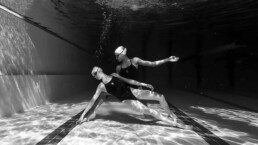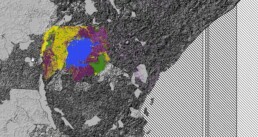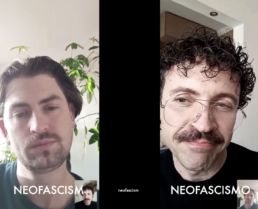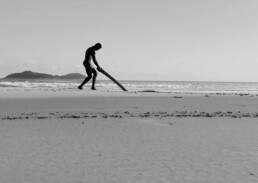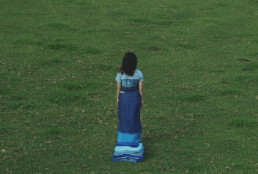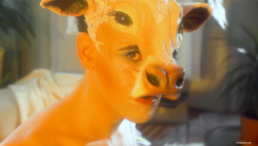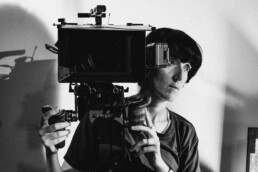FUSO INSULAR 2025 – 23 a 26 de Outubro
24 Outubro, 21h30
Igreja do Colégio (Museu Carlos Machado)
A INOCÊNCIA DO OLHAR? A VIDEOARTE CONTEMPORÂNEA EM PORTUGAL
Curadoria de Jean-François Chougnet
Ao longo de quinze anos, o concurso Open Call do Fuso Lisboa tem-se tornado uma constante no panorama das artes visuais em Portugal, trazendo à luz um dos meios mais efémeros: a videoarte.
Este programa apresenta algumas das obras que foram selecionadas e premiadas no Open Call 2025. Uma pequena mostra – um inventário fragmentário – da videoarte contemporânea em Portugal.
As obras selecionadas, de um total de 208 candidaturas, não são exceção a uma característica observada nas edições anteriores do concurso: uma grande diversidade de origens (desde as artes visuais à performance ao vivo), idades (na verdade, quase três gerações), distintas qualificações académicas e profissionais (da pós-graduação à produção profissional), nacionalidades e locais de residência.
É difícil identificar temas, ainda que as preocupações sociais de hoje encontrem eco: a questão de género e o decolonialismo estão, logicamente, presentes nas obras apresentadas.
Mas o que mais chama a atenção é sobretudo a expressão de uma visão do mundo, de uma sensibilidade, de uma inteligência e de um sentido de humor.
Como disse Nelson Goodman, Languages of Art,1968), “um artista tem muitas vezes razão ao adotar a perspetiva da inocência do olhar.”
Uma informação: segundo as regras do concurso Open Call, as obras devem ser recentes (dos últimos três anos), com menos de 10 minutos de duração e submetidas por artistas portugueses ou com ligações a Portugal, independentemente da idade.
(Jean-François Chougnet)
A Menina do Mar – Inês Ventura
Num bailado submerso entre o real e o imaginado, duas atletas de alta competição — Beatriz Gonçalves e Cheila Vieira — entrelaçam os seus corpos onde o sonho e o desejo de liberdade encontram morada no silêncio das águas profundas da memória. Através da voz de Sophia de Mello Breyner Andresen narrando um excerto d’A Menina do Mar, este filme-ensaio procura na dança e na poesia um palco de luta, de liberdade e da beleza do encontro.
eColonialism – Stephanie Monica
eColonialismo é uma peça audiovisual que interroga a persistência das estruturas coloniais na era digital. Utilizando dados geoespaciais—desde bacias hidrográficas até ao uso do solo e de índices económicos—, a obra expõe como a cartografia, uma prática aparentemente neutra, serve empreendimentos capitalistas e controlo territorial. O vídeo justapõe mapas vibrantes gerados por algoritmos com uma reflexão crítica sobre a digitalização da terra como uma forma de colonialismo moderno. Acompanhada por uma paisagem sonora estéreo, a instalação questiona se a atual dataficação é uma continuação insidiosa e rebatizada da exploração histórica.
Morte de Vénus – Eva Pelúcia
Um poema sobre o conceito de feminilidade e o desassossego dos seus clichês.
My Ray of Sunshine – Laís Andrade
Mãe e filha, separadas pelo oceano, usam ondas sonoras para comunicar.
My Ray of Sunshine (2024) mergulha na memória do tráfico transatlântico de escravos através do conceito de tempo espiralar. A obra imagina as mensagens de voz que uma mãe escravizada poderia ter enviado à sua filha. Um retrato do afeto como ato de resistência à violência da colonização.
N – LealVeileby (António Leal e Jesper Veileby)
“N” faz parte do projeto em desenvolvimento αβ (2019- ), no qual a dupla LealVeileby mapeia a sobreposição linguística (cognatos e “amigos verdadeiros”) entre as suas línguas nativas, o português e o sueco. Para cada letra do alfabeto, a dupla troca diferentes palavras, todas começando pela mesma letra, onde uma inicia e a outra ecoa a palavra correspondente na sua respetiva língua. Com o objetivo de percorrer cada letra do alfabeto latino básico, de forma não sequencial, ao longo de um período de dez anos, cada “cena” funciona como um mapeamento do terreno linguístico comum, bem como um retrato de LealVeileby – tanto como uma dupla de artistas como um casal do mesmo sexo a viver e a trabalhar em conjunto na Europa do século XXI. O jogo linguístico incentiva também o espetador a refletir sobre a sua própria língua, sobre o que se perde na tradução e sobre o porquê de certas palavras serem partilhadas entre diferentes culturas.
O Colon – Welket Bungué
Um corpo humano move-se na natureza, numa síncope narrativa sobre a ecologia das relações e do património histórico. A cinética do corpo combinada com uma contemplação criativa numa síncope narrativa sobre a ecologia dos relacionamentos, existencialismo e pensamento filosófico, convertidos em linguagem fílmica. Como podemos encontrar na imagem os códigos que agregam essencialmente a relação entre o humano-animal-ontológico e a natureza-essência?
Reviralha – Sara Massa
Quero eu que a saia que usarmos tenha frestas onde nós quisermos, que a bainha seja feita onde nós quisermos, tenha bolsos onde…
Sem delimitações, podem e já exigiram tamanho, bainhas… Saia e corpo dependem de números para servir aos olhos de quem não veste.
(As mulheres não podiam usar calças, nem mostrar os joelhos ao usar saia, se o fizessem eram indecentes. Antes das aulas, as saias eram medidas à entrada da sala e não podiam ser mais curtas do que três dedos abaixo do joelho. Nem 100 anos se passaram desde aí. Esta indecência transforma-se numa nova peça. Delimito o baldio com a medida do tamanho das bainhas da decência.)
The Breaking Point – Jonathan Uliel Saldanha e Vera Mantero
Numa existência fechada em si própria, duas criaturas genéricas, semelhantes à fisiologia humana, exploram ciclicamente laboratórios de atividades, em busca de chegar a um qualquer entendimento.
Filme baseado nas personagens ficcionais do espetáculo ‘Esplendor e Dismorfia’ de Vera Mantero e Jonathan Uliel Saldanha
FUSO INSULAR 2025 – October 23rd to 26th
October 24th, 9.30pm
Igreja do Colégio (Museu Carlos Machado)
INNOCENCE OF THE GAZE? CONTEMPORARY VIDEO ART IN PORTUGAL
Curator: Jean-François Chougnet
Over the past fifteen years, the FUSO Lisboa Open Call competition has been a constant presence in the visual arts landscape in Portugal, bringing to light one of the most ephemeral mediums: video art.
This program presents some of the works that were selected and awarded in the Open Call 2025. A small exhibition, a fragmentary inventory of contemporary video art in Portugal.
The selected works, from a total of 208 applications, are no exception to a characteristic observed in the competition’s previous editions: a great diversity of backgrounds (ranging from visual arts to live performance), ages (in fact, nearly three generations), different types of academic and professional qualifications (from postgraduate work to professional production), nationalities, and places of residence.
It is rather difficult to identify specific themes, although today’s social concerns do find resonance: issues of gender and decolonialism are, understandably, present in the works presented. But what stands out the most is, above all, the expression of a worldview, a sensibility, an intelligence, and a sense of humor.
As Nelson Goodman said in Languages of Art (1968), “an artist is often right to adopt the perspective of the innocence of the eye.”
An information: according to the competition rules, the works must be recent (from the last three years), under 10 minutes in length, and submitted by Portuguese artists or those with ties to Portugal, regardless of age. One work is selected to be included in the EDP Foundation’s collection, while the public votes for the Duplacena incentive award.
(Jean-François Chougnet)
The Girl of the Sea – Inês Ventura
In a submerged ballet between the real and the imagined, two high performance athletes — Beatriz Gonçalves and Cheila Vieira — intertwine their bodies where dreams and the longing for freedom find a home in the silent depths of memory. With the voice of Sophia de Mello Breyner Andresen narrating an excerpt from A Menina do Mar, this film-essay seeks,in dance and poetry, a stage for struggle, for freedom, and for the beauty of encounter.
eColonialism – Stephanie Monica
eColonialism is an audio visual piece that interrogates the persistence of colonial structures in the digital age. Using geospatial data—ranging from river basins to land use and economic indices—the piece exposes how mapping, a seemingly neutral practice, serves capitalist ventures and territorial control. The video juxtaposes vibrant, algorithmically generated maps with a critical reflection on the digitisation of land as a form of modern colonialism. Accompanied by stereo soundscape, the installation questions whether contemporary datafication is a rebranded, insidious continuation of historical exploitation.
Morte de Vénus – Eva Pelúcia
A poem about the concept of femininity and the restlessness of its archetypes.
My Ray of Sunshine – Laís Andrade
A mother and daughter, separated by the ocean, use soundwaves to communicate.
My Ray of Sunshine (2024) dives into the memory of the transatlantic trade of slaves through the concept of spiral time. It imagines the voice messages that an enslaved mother might have sent to her daughter. A portrayal of affection as an act of resistance to the violence of colonization.
N – LealVeileby (António Leal and Jesper Veileby)
“N” is part of the ongoing project αβ (2019- ) in which the duo LealVeileby maps the linguistic overlap (cognates and “true friends”) between their native languages, Portuguese and Swedish. For each letter of the alphabet they exchange different words all beginning with the same letter, where one initiates the other one follows by echoing the corresponding word in their respective language. With the aim to cover every letter in the basic Latin alphabet, non-sequentially, over a ten year period, each “scene” functions as a mapping of linguistic common ground as well as a portrait of LealVeileby – both as an artist duo and a same-sex couple living and working together in 21st century Europe. The linguistic game also encourages the viewer to reflect over their own language, on what is lost in translation, and on why certain words are shared between different cultures.
The Settler – Welket Bungué
A human body moves through nature. Body kinetics mixed with creative contemplation underlined by a narrative syncope of an ecology of relationships, existentialism and philosophical thought converted into filmic language. How can we find in the image, the codes that essentially aggregate the relationship between the human-animal-ontological, and nature-essence?
Reviralha – Sara Massa
I want the skirt we wear to have gaps wherever we want, to be hemmed wherever we want, to have pockets wherever…
Without limitations, they can and have demanded sizes, hems… Skirts and bodies depend on numbers to fit the eyes of those who don’t wear them.
(Women were not allowed to wear pants or show their knees when wearing skirts, if they did they were indecent. Before school, skirts were measured at the entrance to the classroom and they couldn’t be shorter than three fingers below the knee. Not even 100 years have passed since then. This indecency is transformed into a new piece. I delimit the wasteland by measuring the size of the hems of decency).
The Breaking Point – Jonathan Uliel Saldanha and Vera Mantero
In a self-enclosed existence, two generic creatures, similar to human physiology, cyclically explore laboratories of activity, in search of some kind of understanding.
Film based on fictional characters from the play ‘Esplendor e Dismorfia’ by Vera Mantero and Jonathan Uliel Saldanha
